
Deep down, we all hoped President Trump’s ‘big, beautiful wall’ was just a ruse — an attempt to incite American sentiment and shift votes into his rather small hands. But by all accounts, the man seems to be serious about it. If left to his devices, it seems quite likely that a 1,300-mile-long concrete wall will be erected along the US-Mexico border. Even if it’s as big and grandiose as Trump boasts, research suggests it won’t stop the flow of illegal immigrants into the country (on the contrary) or drugs. But if there’s one thing this border wall will be good at is stopping animals from flowing in and out of Central America northwards, and vice-versa.
According to the US Fish & Wildlife Service (FWS) “111 endangered species, 108 species of migratory bird, four wildlife refuges and fish hatcheries, and an unknown number of protected wetlands” could be threatened by Trump’s border wall which genetically isolates populations and blocks seasonal migration. These include ocelots, bears, Bighorn sheep or the last wild jaguars in the US. Even the US national bird, the Bald eagle, will be affected by this wall which is set to disrupt its habitat.
The border with Mexico is around 3,100 km (1,900 miles) long, and much of it is already fenced off. Trump’s plan is to erect a 1,300 miles long, 40-feet-high wall which contains 19 million tons of concrete and could cost in excess of $25 billion. Along with natural barriers, this ‘Great Wall of America’ should keep illegal immigrants and drugs flowing into the country, although we previously reported that over the years as the United States militarized its borders, more and more undocumented immigrants stayed into the country — simply because they got stuck there. For every million-dollar increase in budget, the odds a migrant would return home to Mexico in any given year dropped by 89 percent.
The FWS’ report is “for informational purposes only and should not be used for official planning purposes”. Outside reports section 7 of the Endangered Species Act clearly stipulates any construction project “permitted, funded, or licensed by any federal agency” has to be reviewed by the FWS but the Trump Administration has made no such request.
Trust Resources TrumpWall by Outside on Scribd
Most of these animals are negatively impacted by the wall because it isolates cross-border populations. If a solid, concrete wall is erected, it’s likely inbreeding will increase and genetic diversity will decrease, making species more vulnerable. The few jaguars that roam in Arizona and New Mexico will probably slowly but surely get wiped out from the United States as these become stranded, unable to mate with more numerous populations south of the border. Even the bald eagle or manatees, flying and marine species which at first glance shouldn’t be affected, will be threatened by the wall which encroaches on their critical habitat.
As The Ecologist reports, a 2011 study which assessed bioconservation at the US-Mexico border found barriers significantly impede animal migrations within this ecologically sensitive region. In other words, the fences already in place at the border put more than 50 species at risk. The authors of the study cautioned at the time that “New barriers along the border would increase the number of species at risk, especially in the three identified regions, which should be prioritized for mitigation of the impacts of current barriers.”
All of these reports likely fall on deaf ears, though. There seems to be little to any consideration given to official reports, figures, data, or experts for that matter. Trump’s ‘educated guesses’ as to how much this planned border wall would cost — he’s been quoted as saying around $5 billion when the real cost would be at least five times that, and far more if you account maintenance over the coming decades — is very telling of how much thought goes into the Presidential Administration’s executive orders.






